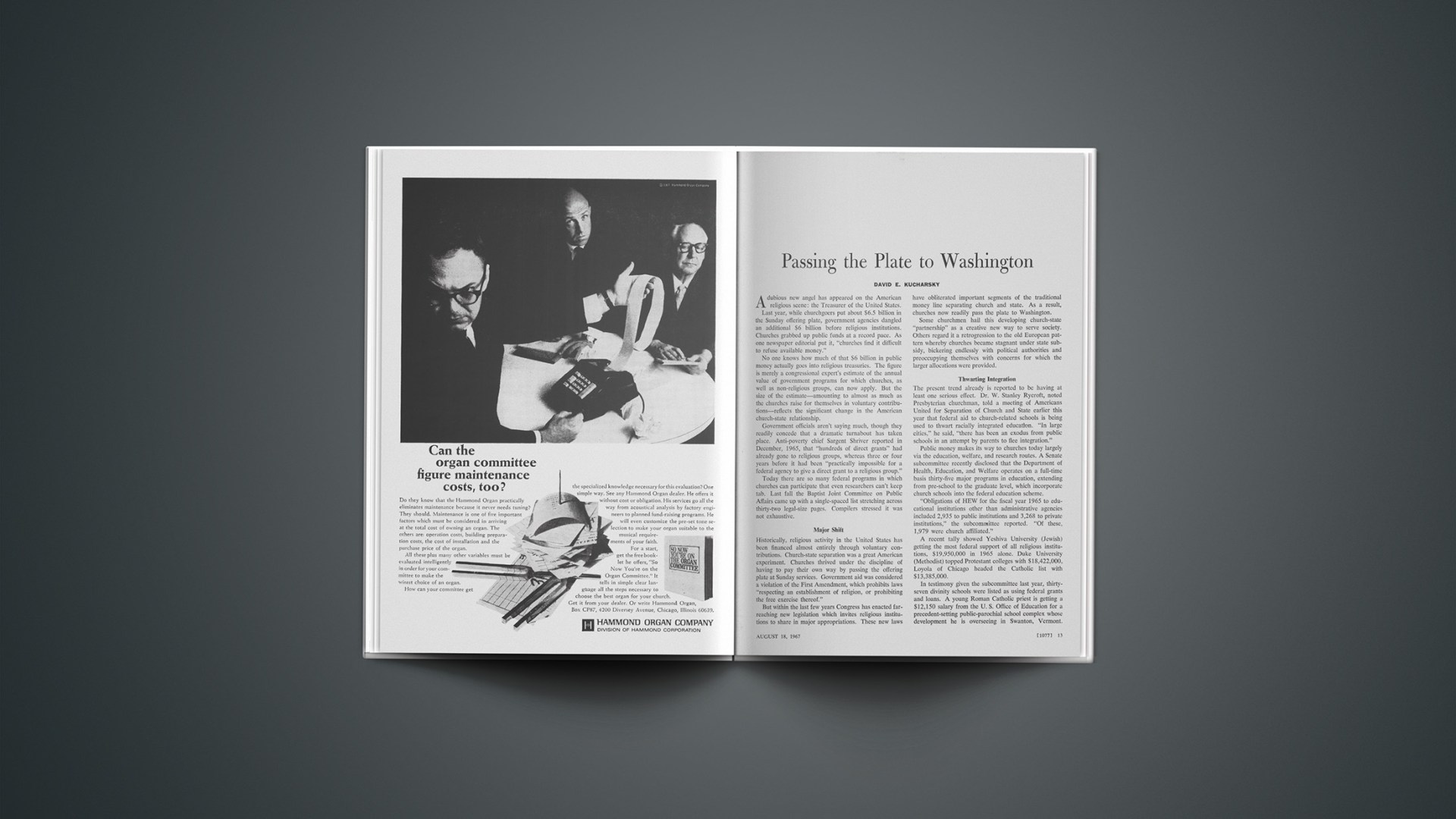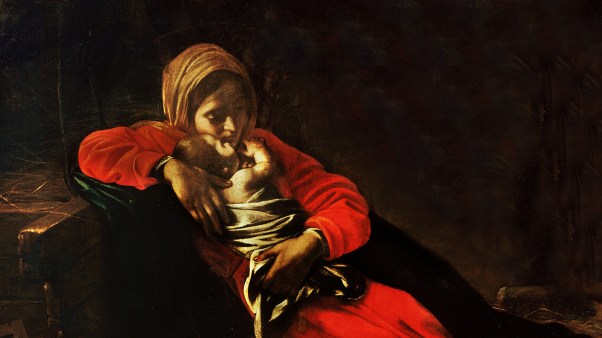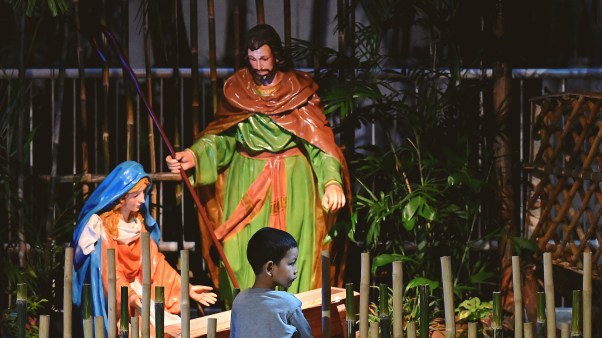Adubious new angel has appeared on the American religious scene: the Treasurer of the United States. Last year, while churchgoers put about $6.5 billion in the Sunday offering plate, government agencies dangled an additional $6 billion before religious institutions. Churches grabbed up public funds at a record pace. As one newspaper editorial put it, “churches find it difficult to refuse available money.”
No one knows how much of that $6 billion in public money actually goes into religious treasuries. The figure is merely a congressional expert’s estimate of the annual value of government programs for which churches, as well as non-religious groups, can now apply. But the size of the estimate—amounting to almost as much as the churches raise for themselves in voluntary contributions—reflects the significant change in the American church-state relationship.
Government officials aren’t saying much, though they readily concede that a dramatic turnabout has taken place. Anti-poverty chief Sargent Shriver reported in December, 1965, that “hundreds of direct grants” had already gone to religious groups, whereas three or four years before it had been “practically impossible for a federal agency to give a direct grant to a religious group.” Today there are so many federal programs in which churches can participate that even researchers can’t keep tab. Last fall the Baptist Joint Committee on Public Affairs came up with a single-spaced list stretching across thirty-two legal-size pages. Compilers stressed it was not exhaustive.
Major Shift
Historically, religious activity in the United States has been financed almost entirely through voluntary contributions. Church-state separation was a great American experiment. Churches thrived under the discipline of having to pay their own way by passing the offering plate at Sunday services. Government aid was considered a violation of the First Amendment, which prohibits laws “respecting an establishment of religion, or prohibiting the free exercise thereof.”
But within the last few years Congress has enacted far-reaching new legislation which invites religious institutions to share in major appropriations. These new laws have obliterated important segments of the traditional money line separating church and state. As a result, churches now readily pass the plate to Washington.
Some churchmen hail this developing church-state “partnership” as a creative new way to serve society. Others regard it a retrogression to the old European pattern whereby churches became stagnant under state subsidy, bickering endlessly with political authorities and preoccupying themselves with concerns for which the larger allocations were provided.
Thwarting Integration
The present trend already is reported to be having at least one serious effect. Dr. W. Stanley Rycroft, noted Presbyterian churchman, told a meeting of Americans United for Separation of Church and State earlier this year that federal aid to church-related schools is being used to thwart racially integrated education. “In large cities,” he said, “there has been an exodus from public schools in an attempt by parents to flee integration.”
Public money makes its way to churches today largely via the education, welfare, and research routes. A Senate subcommittee recently disclosed that the Department of Health, Education, and Welfare operates on a full-time basis thirty-five major programs in education, extending from pre-school to the graduate level, which incorporate church schools into the federal education scheme.
“Obligations of HEW for the fiscal year 1965 to educational institutions other than administrative agencies included 2,935 to public institutions and 3,268 to private institutions,” the subcommittee reported. “Of these, 1,979 were church affiliated.”
A recent tally showed Yeshiva University (Jewish) getting the most federal support of all religious institutions, $19,950,000 in 1965 alone. Duke University (Methodist) topped Protestant colleges with $18,422,000, Loyola of Chicago headed the Catholic list with $13,385,000.
In testimony given the subcommittee last year, thirty-seven divinity schools were listed as using federal grants and loans. A young Roman Catholic priest is getting a $12,150 salary from the U. S. Office of Education for a precedent-setting public-parochial school complex whose development he is overseeing in Swanton, Vermont. Forty Unitarian-Universalist ministers are receiving free gerontologic training at Pennsylvania State University under a $24,913 federal grant.
The government’s war on poverty is also involved very closely with the churches. An estimated $90,000,000 is meted out annually through the churches by the Office of Economic Opportunity. Half of a Chicago Head Start program was recently described as being sponsored by church-related organizations. Much more could probably be channeled through churches if anti-poverty officials did not on their own clamp an arbitrary 10 per cent ceiling upon religiously related expenditures.
Theoretically, government funds are not to be used for religious instruction, proselyting, or ritual. Church-related institutions are forbidden from making membership or belief a condition for receiving aid. But there is plenty of latitude and many a loophole in the guidelines, and precious little policing. At one Methodist church, the ladies’ auxiliary took on a Head Start program as its “missionary project” for the year with the result that “several families of the children are now members of the church.”
Some current government projects are questionable not only because they involve a religious institution as a financial channel but also because there is uncertainty whether they really serve the public interest. A $25,000 grant went to Seattle Pacific College, operated by the Free Methodist Church, for one of its zoology teachers to research “the relationships of the development of intestinal parasites to the frog’s change from a tadpole to an adult.” Another grant went to Brooklyn’s Lutheran Medical Center for a “psychological and linguistic study” of glossolalia.
To be sure, much government-financed research is commendable. At Baylor University, owned and run by Southern Baptists, more than $1,000,000 in public funds was expended in the development of an artificial heart. Much of the federal money taken by Baylor—$9,770,000 during 1965—was earmarked for research.
Local and state governments also participate in wholesale giveaways to churches and related institutions. In New York, half the welfare money is said to be distributed through church-related philanthropic groups. But at this level, the boon is more often in the form of surplus government property deeded to churches at prices far below actual market value. Urban redevelopment projects, moreover, have helped many churches to relocate and rebuild at considerable financial gain.
The speed with which some churches have responded to government offers is especially impressive. There has been a reported 75 per cent church sponsorship of the low-income supplementary rental housing. And in the first four years of the FHA mortgage-insurance program for senior citizens’ housing, religious groups were the largest category of non-profit sponsors.
At that, churches apparently don’t move fast enough to suit the government. Vice-President Hubert Humphrey chided churchmen attending the National Council of Churches assembly in Miami Beach last December for not being sufficiently aggressive in taking up the government offer of long-term low interest loans under the 221D3 provision of the Housing Act. He said he had worked hard for that clause.
Actually, federal benefit programs have mushroomed so quickly that apparently they haven’t been reconciled with existing policies. A college student can get a vast assortment of government grants and loans to finance his education. But if he earns the money, he can’t even claim tuition expenditures as an income-tax deduction.
So far, the American people have accepted the principle of government as a big new benefactor of the churches with no great qualms. Involvement has become so great that any substantial backtracking is unlikely, especially since inflation has put serious crimps in many religious institutional budgets. Yet some people are asking, “How have the churches become so enmeshed in government programs, considering that there has been no significant public debate over the propriety of the change in policy?” Such people point to a 1966 Gallup survey indicating a growing measure of public opinion against government aid to religion.
The drift can be traced back to the days following World War II, when thousands of clergymen were trained at government expense because they had served in the military. In a similar vein, the Hill-Burton Act of 1946 granted federal funds for hospitals, and church-related hospitals were made eligible with the rest. The Housing Act of 1950 and other pieces of social legislation perpetuated the trend. America’s youngsters, in parochial as well as public schools, were introduced to publicly-paid-for milk, lunch, and bus transportation.
The Soviet launching of Sputnik indirectly spawned the next big step, for it led to enactment of the National Defense Education Act of 1958. CHRISTIANITY TODAY, in one of the few times it has ever criticized specific legislation, then charged that the NDEA “virtually provides a new formula that gives advocates of tax funds for parochial schools what they want.”
All these programs, however, were but preliminaries to the main events, which took place between 1963 and 1965. President Kennedy, as the first Roman Catholic in the White House, took a hard line against federal aid to parochial schools on the elementary and secondary level. Nonetheless, he advocated more money from Washington for colleges, church-related and others. Thus the Higher Education Facilities Act was passed to aid campus construction. The 1967 fiscal year appropriation was $722,744,000. Georgetown University, a leading Jesuit school, is getting one of the biggest grants, a whopping $2,338,530, to erect a law center in the nation’s capital.
In 1964 came the declaration of the war on poverty with passage of the Economic Opportunity Act, the administration of which freely utilizes churches and specially created religious agencies as conduits and buffer entities for disbursement of aid (the environment is supposed to be “religiously sterile,” but OEO officials “don’t feel that we can justifiably insist that they take the cross off the point of the building or remove a ten-ton statue”). In the enthusiasm for alleviation of suffering, the adverse implications of the bill upon the church-state separation principle were ignored. The bigger noise that year was over the issue of Bible reading and prayer in public schools. The Republican platform favored restoration of classroom devotions. Neither political party took a stand on the money line separating church and state.
New Precedents
With the election of a number of additional Democrats to Congress, President Johnson won new power to enact legislation. Among the precedent-setting new bills were the Higher Education Act of 1965 and the Elementary and Secondary Education Act, both of which opened wide new doors into the U. S. Treasury for church-related institutions.
Implementation of the ESEA has been especially thorny, though the church-state issue therein had purportedly been resolved on the basis of an old, resurrected “child-benefit theory.” Methodist Bishop Richard C. Raines of Indianapolis calls the child-benefit claim “but a subterfuge which excuses us for doing indirectly what law forbids us to do directly. A leaky roof of a parochial school can be fixed at public expense, free textbooks provided, teachers hired, buildings built, and pupils bussed to school—all under the child-benefit umbrella.” ESEA’s appropriation for fiscal year 1967 alone amounted to $1,342,410,000. The taxpayer can only guess how much of this figure is being used in parochial schools.
All the new intrusions on the church-state separation principle came about, not by specific government design or as the result of some secret conspiracy, but as a byproduct of mushrooming social legislation. Historians will doubtless record, however, the growing Roman Catholic Church as a predominant force behind the big change. The church has consistently lobbied for tax money at all levels. Its hierarchy has never really accepted the church-state separation principle. For a long time, Protestant leaders stood up to Roman Catholic demands for public money. More recently, however, their resistance has dwindled in the spirit of ecumenicity. With all the government money American Catholic institutions now get, they still refuse to follow the lead of their Protestant brethren in making public their financial statements.
Protestant churchmen have contributed to the shift not only through silence but by promotion of the concept of the secularization of the church. “If they have their way,” says Time, “it may be hard in the future to tell where the church begins and the world leaves off.” This raises the basic problem of enforcement of church-state separation. How can church-state separation be insured when the secular cannot be distinguished from the sectarian?
The churches’ preoccupation with social issues today adds to the problem. It also poses a trap. The more the churches accept tax money, the more they yield independence and integrity and drift toward where the money is. Inasmuch as public policy determines the disposition of public money, churches could eventually find themselves instruments of public policy rather than influencers.
Few churchmen are sensitive to the dangers. They scream at the implications of accepting CIA funds but apparently see no problem in taking money from the Defense Department or the National Science Foundation or HEW. They appear indifferent to the repeated accusations from abroad that American churchmen are agents of official Washington.
One liberal churchman who has dared to buck the tide is the Rev. Dean M. Kelley, director of the National Council of Churches’ Department of Religious Liberty. He contends that the church has “its own unique and indispensable service to perform for society, as important as that of government.” He warns against churchmen who are beginning to act like “brokers of civil power.”
It must be said, with all due respect, that there are many well-meaning, devout citizens who see the erosion of spiritual values as much more serious than the separation principle. They interpret the First Amendment as prohibiting only the establishment of a single church, not the financial support of all churches. Edwin Palmer, a Protestant leader of the predominantly Catholic lobby known as Citizens for Educational Freedom, worries particularly about an adverse religious effect from the withholding of public funds from parochial schools. People like Palmer feel this coerces Christian parents into giving their children a debilitating, secularistic upbringing in the public schools. They also point to the fact that parochial schools save taxpayers about $2.1 billion annually.
A Better Hope
On the other hand, CEF fails to see the incipient wrong in bringing the churches under the mercy of public policy, of letting politics call the shots rather than spiritual priorities or even human need, and of letting the government pay the bill for welfare for which churches get credit. CEF might well better channel its resources into campaigns for voluntary contributions—fund-raising counsel say there is more contribution money available today than ever before.
Aside from a great popular outcry against public aid for sectarian activity, the one hope left for the separation principle lies with the courts. The U. S. Supreme Court has yet to rule on the constitutionality of government support of religious schools. If it were to outlaw such support, the effect could be far-reaching.
Many court cases are pending, but so far they have been hung up on a legal technicality. Taxpayers have no standing to sue and thereby test the constitutionality of legislation, unless they can establish specific damage. U. S. Senator Sam J. Ervin, Jr., of North Carolina, is trying to overcome the obstacle with a special bill. It would pave the way for judicial review of most major legislation under which churches are tapping the federal treasury.










